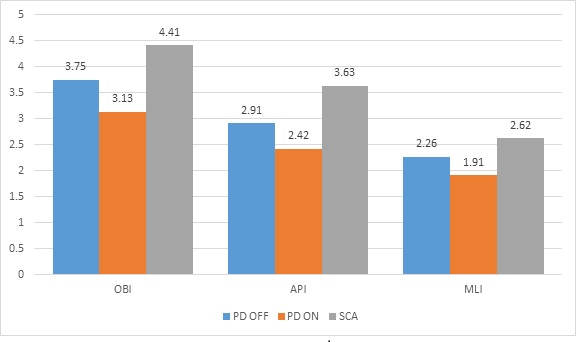Objective: This study is conducted to compare the balance impairment between Parkinson Disease in both OFF and ON state and Spinocerebellar Ataxia.
Background: The dynamic interplay between cortical and sub-cortical structures are essential for the maintenance of normal erect posture and gait. The gait characteristics of PD and SCA has been compared in earlier studies and suggested to have increased gait instability, attributed by balance impairment predominantly presents in each condition yet in a distinctive manner. [1, 2] The step to step variability in SCA is indicative of the adaptive and compensatory mechanisms arisen out of balance deficits. [3] However, no quantitative studies have found the degree of balance impairment between these major neurological conditions. The information obtained in our study may help in planning diseases specific rehabilitative strategy to improve mobility outcome.
Method: The study consisted of two groups, with 30 patients diagnosed with PD in Group A and 30 patients in Group B who were diagnosed with SCA. All patients were in the chronic stage with no other comorbidities. Dynamic posturography was performed using Biodex Balance Master SD, and the postural sway was assessed using Overall Balance Index (OBI), Anteroposterior Index (API) and Mediolateral Index (MLI). Group A was assessed in both OFF stage and ON stage (20 minutes after medication). T-test analysis was performed to analyse the recorded data.
Results: The mean age of Group A and B was 62.73±7.18 and 37.53±11.49, respectively. SCA had higher balance deficits when compared with PD in all 3 balance indices (Figure 1). Independent T-test analysis did not demonstrate any significant difference (p>0.05) between SCA and PD in OFF stage for the indices under consideration. But significant difference was identified between SCA and PD in ON stage (p<0.05). Paired T-test analysis between OFF and ON stage also demonstrated statistical significance (p<0.05).
Conclusion: This study has found a predominant balance deficit in anteroposterior (AP) direction in spinocerebellar ataxia in comparison with Parkinson disease. Hence the balance interventions have to be focussed on improving AP deficits in SCA, to improve mobility outcomes. It is likely that balance deficit in PD shall be beyond AP direction. However this inference needs to be confirmed in future studies with large samples and with various types of SCA.
References: 1. Ebersbach G, Sojer M, Valldeoriola F, Wissel J, Müller J, Tolosa E, Poewe W. Comparative analysis of gait in Parkinson’s disease, cerebellar ataxia and subcortical arteriosclerotic encephalopathy. Brain. 1999 Jul 1; 122(7):1349-55. 2. Mohan G, Pal PK, Sendhil KR, Thennarasu K, Usha BR. Quantitative evaluation of balance in patients with spinocerebellar ataxia type 1: A case-control study. Parkinsonism & related disorders. 2009 Jul 1; 15(6):435-9. 3. Serrao M, Pierelli F, Ranavolo A, Draicchio F, Conte C, Don R, Di Fabio R, LeRose M, Padua L, Sandrini G, Casali C. Gait pattern in inherited cerebellar ataxias. The Cerebellum. 2012 Mar 1; 11(1):194-211.
To cite this abstract in AMA style:
V. Selvaganapathy, T. James, M. Philip, N. Kamble, A. Bhattacharya, A. Stezin, P. Dhargave, P. Pal, V. Muralidharan, M. P S, P. Kishore. Comparative Measurement of Balance between Parkinson Disease and Spinocerebellar Ataxia – A Dynamic Posturography Study [abstract]. Mov Disord. 2021; 36 (suppl 1). https://www.mdsabstracts.org/abstract/comparative-measurement-of-balance-between-parkinson-disease-and-spinocerebellar-ataxia-a-dynamic-posturography-study/. Accessed December 23, 2025.« Back to MDS Virtual Congress 2021
MDS Abstracts - https://www.mdsabstracts.org/abstract/comparative-measurement-of-balance-between-parkinson-disease-and-spinocerebellar-ataxia-a-dynamic-posturography-study/

